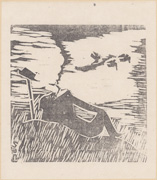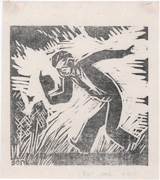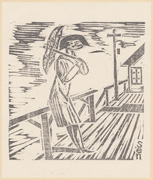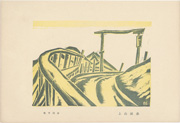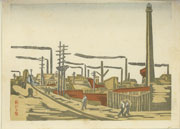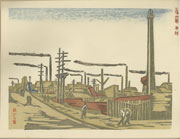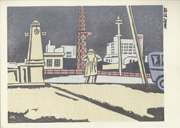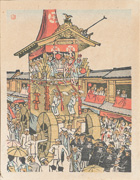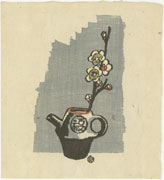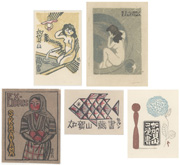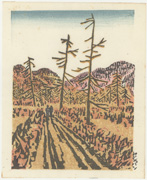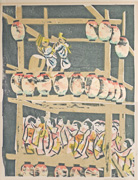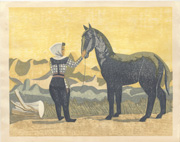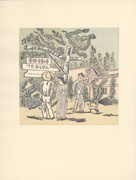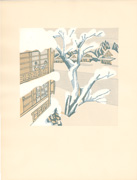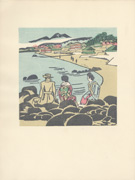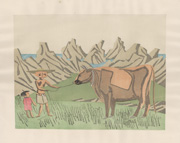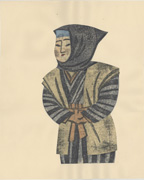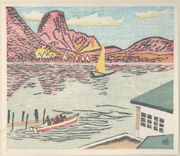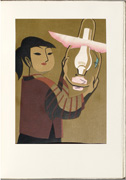Prints in Collection
IHL Cat. #2016
IHL Cat. #2017
Distant View of Snow and Komagatake, 1953
IHL Cat. #1520
Triangular Hood, 1958
IHL Cat. #2031
Lake Haruna in Autumn, 1959-1960
IHL Cat. #1417
Lamp (Ranpu), 1962
IHL Cat. #1336b
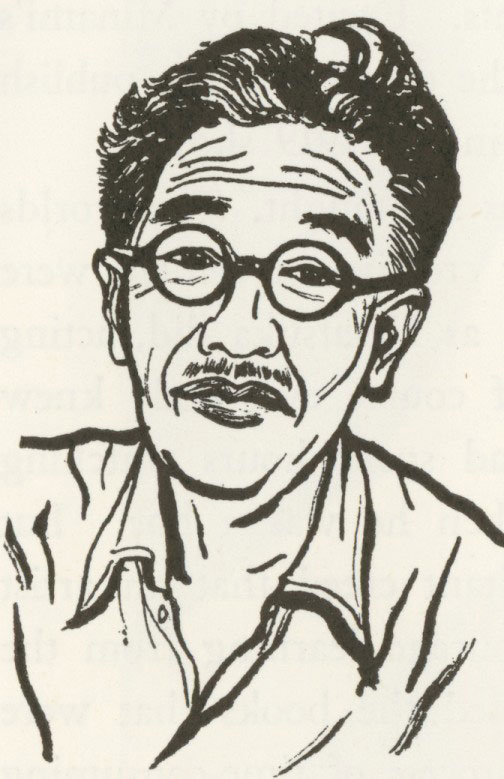
Biography
Maekawa Senpan 前川千帆 (1888-1960)Note 1: "Senpan" is sometimes seen as "Sempan"
Note 2: Portrait of the artist (shown left) from Modern Japanese Woodblock Prints: AnArt Reborn, by Oliver Statler, Charles E. Tuttle Co., 1956, p. 45
Sources: Modern Japanese Prints – An Art Reborn, Oliver Statler, Charles E. Tuttle Company, 1956, p. 45; Japanese Wood-block Prints, Shizuya Fujikake, Japan Travel Bureau, 1949, p. 146-147; Guide to Modern Japanese Woodblock Prints: 1900-1975, Helen Merritt, University of Hawaii Press, 1992, p. 84 and as footnoted
Maekawa Senpan (前川千帆,1888-1960)) was born in Kyoto on October 5, 1888 with the name Ishida Shigezaburō. In 1905 he took the name Maekawa from a relative on his mother's side after his father's death. He attended Kansai Fine Art Academy in Kyoto studying with Asai Chū (1856-1907) and later with Kanokogi Takeshiro (1874-1941). He moved to Tokyo in 1911 where he became popular as a caricaturist, publishing his works in newspapers such as the Yomiuri shinbun and the Kokumin shinbun and in the satirical magazine Tokyo pakku (Tokyo Puck). His cartoons dealt with the habits and customs of ordinary people and he traveled throughout Japan gathering material on local customs for his work.
He became interested in prints after seeing the work of Minami Kunzō (1883-1950), a sōsaku hanga artist, in 1911. Like many sōsaku hanga artists Maekawa was self-taught and experimented with printmaking for a number of years before publishing his first print in 1919 and showing at the Nippon Sōsaku Hanga Kyokai1 exhibition. In later years he commented that "It took me ten years to learn technique; later I got acquainted with some artisans and found they could have taught me the same thing in a few hours."
Maekawa was active in the Nippon Sōsaku Hanga Kyokai and became "one of the stalwarts of the sōsaku hanga movement."2 He was an active member of the Japanese Print Association from 1931 to 1960.
After WWII his prints, many of which depicted colorful festivals and customs, became popular with the occupation forces allowing him to make his living as a print artist. One of his most famous series of prints, Hot Spring Notes (Hanga yokusen fu), depicts various hot springs around Japan and was published over an 18 year period (1941-1959) in five volumes, with each volume containing 20 prints.
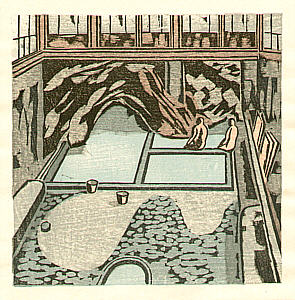 (Volume 1, No. 19, 1941) | 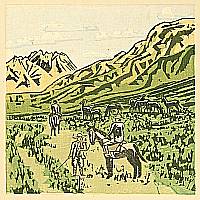 (Volume 2, No. 15, 1944) |
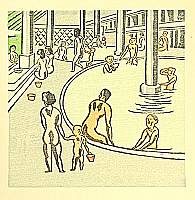 Noboribetsu Noboribetsu(Volume 4, No. 2, 1956) |  (Volume 4, No. 16, 1956) |
Hot Spring Notes - four prints
He participated in many major group series, such as One Hundred New Views of Tokyo (twelve prints) and One Hundred New Views of Japan, part of which he was in charge of printing. Major print works of his own design were the portfolio Karuizawa from Nihon fukei hanga (1939), the five albums of Yokusen fu (Hot Springs, 1941-59) and an extended series of small woodblock books called Kanchu kanbon (Leisure Time Leisure Books, 1945-60). He first exhibited abroad at the São Paolo Biennale in 1953. He achieved Western recognition through inclusion in Oliver Statler's Modern Japanese Prints: An Art Reborn (1956) and James Michener's portfolio and book The Modern Japanese Print. An Appreciation (1962). He "was one of the great personalities of twentieth-century Japanese prints, a man of notable independence, and a political radical, yet a staunch traditionalist and supporter of Japanese folk life and customs."3
Signatures and Seals
 前川千帆 |  |  帆 帆 |  帆 |  帆 |  sen |  (in seal script) |
1 The Nippon Sosaku Hanga Kyokai was formed in June, 1918 and included Kanae Yamamoto, Kazuma Oda, Kogan Tobari, Takeo Terazaki, Onchi Kōshirō, Tsurozo Ishii, Itaru Tanabe, Yoshiro Nagase, Un-ichi Hiratsuka, Senpan Maekawa and Masahide Asahi. Its objectives were to disseminate information on the art of engraving, promote the print arts through exhibitions and lobby to have prints exhibited at the Teiten (Salon of the Imperial Art Institute) and establish a Department of Engraving at the Tokyo Academy of Fine Arts. It eventually succeeded in its objectives.
2 Images of a Changing World: Japanese Prints of the Twentieth Century, Donald Jenkins, Portland Art Museum, p. 72.
3 The British Museum website Biographical Details Maekawa Senpan http://www.britishmuseum.org/research/search_the_collection_database/term_details.aspx?bioId=146144
last revision:
12/11/2018
